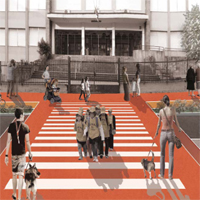Walking (and cycling) to change the city
Abstract
Contemporary city is mainly designed and managed in order to meet drivers' needs (and those of their vehicles!). (Alagia, Chiusaroli 2000; Viale 2007; Ward 1978)
And since there is an unsolvable conflict between drivers' and pedestrians' needs (and cyclists, skaters, runners, ... needs too), we can say that contemporary city is not capable of ensuring the right of pedestrians (and cyclists) to safely and freely walk (and to safely and freely cycle). (Illich 2006; Labbucci 2011; Viale 2007)
Urban traffic congestion has a number of negative effects: road accidents, air pollution, noise pollution, time wastage, privatization of public spaces, limitation of the right of pedestrians (and cyclists) to walk (and to cycle). All these negative effects cause a significant reduction of everyday quality of life for everyone: both people who use car and people who cannot or does not want to. (Alagia, Chiusaroli 2000; Viale 2007)
Urban planning has to guarantee the right to actually "use" the city for every and each individual, including pedestrians (and cyclists).
To achieve this goal it is necessary to make policies aimed at reducing the overall number of cars. The engagement of people (voluntary, aware and responsible) is essential to make these policies work.
Therefore, urban planning has to deal with this issue: how can social learning be effectively enhanced to promote a cultural change in mobility behaviour?
Until now, urban planning has mainly referred to reasons of environmental sustainability. (Viale 2007)
Results are not satisfactory. Most Italian cities are still hostile to pedestrians (and cyclists), especially to the most vulnerable groups: children, elderly people, disabled people, etc.
Perhaps, reasons of environmental sustainability are not much effective because of their individualistic nature and since they refer especially to long term effects of actions. (Elster 1993; Illich 2006; Viale 2007)
Urban planning probably should concentrate more on reasons of the right to the city.
There are people who choose to be pedestrians (or cyclists) for reasons of the right to the city: they walk (or cycle) to interfere with established urban design and management, in order to claim their right to "use" the city.
Their main goal is to free the streets and the public spaces from cars and to bring them back to pedestrians (and cyclists).
People who promote and participate in collective initiatives like Critical Mass, Walking School Bus, Parking Day, etc. can be considered part of this category.
In this paper, we will try to explain why and how referring to assumptions and characteristics of these collective initiatives of re-conquest of the streets and the spaces of the city (public on paper, but private de facto) can be useful to make more effective policies aimed at building walkable (and cyclable) cities.
Downloads
References
Alagia A., Chiusaroli C. (2000) Chi si muove è perduto. Scenari, tecniche e strumenti per una "nuova mobilità": percorsi possibili, probabili, o solo immaginabili, Federtrasporti, FENIT
Baruzzi V., Drufuca A., Sgubbi G. (a cura di) (2004) La città senza incidenti. Strategie, metodi e tecniche per progettare mobilità sicura, La Mandragora, Imola
Benjamin W. (2007) I passagges di Parigi, Einaudi, vol. 1
Bradbury R. (1951) "The pedestrian"
Braess D. (1968) "Über ein Paradoxon aus der Verkehrsplanung", Unternehmensforschung 12, 258–268 (trad. "On a paradox of traffic planning")
Debord G. (1958) “Théorie de la dérive”, Internationale Situationniste n. 2
Illich I. (2006) Elogio della bicicletta, Bollati Boringhieri Editore, Torino (edizione originale Energie et équité, 1973)
Francis M. (1991) "The making of democratic streets", in A. Vernez Moudon (1991) (ed.) Public Streets For Public Use, Columbia University Press, New York
Grosz E. A. (1995) Space, Time and Perversion. Essays on the Politics of Bodies, Routledge, New York
Labbucci A. (2011) Camminare, una rivoluzione, Donzelli Editore, Roma
Lynch K., Lukashok A. (1990) “Some childood memories of the city”, Banerjeer, Southworth M. (ed.) City sense and city design: writing and projects of Kevin Lynch, Mit Press, Cambridge/London
Pecoriello A.L. (2006) “La città in gioco”, Paba G., Pecoriello A. L. (2006) La città bambina. Esperienze di progettazione partecipata nelle scuole, Masso delle Fate, Signa (Firenze)
Sen A. (2009) The Idea of Justice, Harvard University Press
Sen A.K. (1999) Development as freedom, Knopf Press, New York
Sen A.K. (1992) Inequality Reexamined, Harvard University Press, Cambridge, Mass.
Solnit R. (2005) Storia del camminare, Mondadori, Milano
Taniguchi J. (1999) L'uomo che cammina, numero 47, anno 1999, Planet Manga (edizione originale 1992)
Urbinati N. (2008) "L'Italia docile che ha perso dissenso", La Repubblica, 20 agosto 2008
Viale G. (2007) Vita e morte dell'automobile. La mobilità che viene, Bollati Boringhieri, Torino
Ward C. (1978) The child in the city, Architectural Press, London

Copyright (c) 2014 Tema. Journal of Land Use, Mobility and Environment

This work is licensed under a Creative Commons Attribution 4.0 International License.
Authors who publish in this journal agree to the following:
1. Authors retain the rights to their work and give in to the journal the right of first publication of the work simultaneously licensed under a Creative Commons License - Attribution that allows others to share the work indicating the authorship and the initial publication in this journal.
2. Authors can adhere to other agreements of non-exclusive license for the distribution of the published version of the work (ex. To deposit it in an institutional repository or to publish it in a monography), provided to indicate that the document was first published in this journal.
3. Authors can distribute their work online (ex. In institutional repositories or in their website) prior to and during the submission process, as it can lead to productive exchanges and it can increase the quotations of the published work (See The Effect of Open Access)
